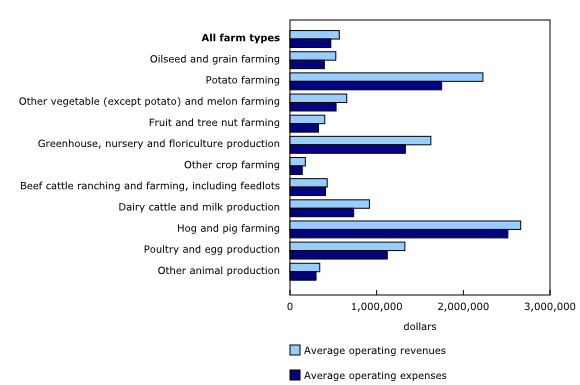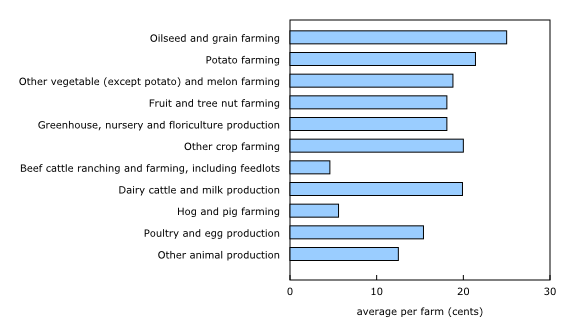Farm operating revenues and expenses, 2020
Archived Content
Information identified as archived is provided for reference, research or recordkeeping purposes. It is not subject to the Government of Canada Web Standards and has not been altered or updated since it was archived. Please "contact us" to request a format other than those available.
Released: 2022-03-25
In addition to climate change and trade barriers being major factors that greatly affected farming, 2020 added another factor with the global COVID-19 pandemic. Despite this, Canadian farmers experienced a profitable year due in large part to higher crop revenues, bouncing back after a year of reduced exports to China.
In 2020, agricultural operations reported $568,708 in operating revenues on average, up 12.0% from 2019. Average operating expenses also increased but by a smaller margin (+9.1%), to $470,973. As a result, average net operating income increased by 28.5% to reach $97,736 in 2020.
The average operating profit margin (the ratio of net operating income to operating revenue) stood at 17.2 cents per dollar of revenue in 2020, compared with 15.0 cents per dollar in 2019.
The gain in average operating revenue was mainly attributable to the higher revenues of total crops (+17.7%) and livestock products (+10.8%). The increase in operating expenses was largely driven by increases in the cost of livestock feed (+11.1%) and livestock purchases (+17.7%).
The Agriculture Statistics Program introduced a new definition of the farm in 2020. This new definition is based on operations reporting agricultural revenues and expenses as opposed to the previous definition, which was based on the intention to sell agricultural commodities. While this change provided results that were more reflective of business operations involved in agriculture, data users are advised to use caution when comparing data from previous years.
Crop revenues accounted for 48.0% of all operating revenues earned by Canadian farms in 2020, while livestock revenues accounted for 40.5%. The remaining revenues came from program payments, insurance proceeds, as well as from other revenues, such as custom work and machine rental.
Oilseed and grain farms had the highest average operating profit margin in 2020
The increased operating profit margins of grain and oilseed farms were largely due to strong export demand and favourable weather conditions in Western Canada, which resulted in average or above average yields of harvested grain and oilseed crops.
In 2020, the average net operating income of oilseed and grain farms amounted to $131,791. Of the 11 major farm types, oilseed and grain farms had the highest operating profit margin, at 25.0 cents per dollar of revenue.
Oilseed and grain farms had the lowest operating expense to revenue ratio at 75.0 cents spent per dollar earned, followed by potato (79.0 cents spent per dollar earned) and other crop farms (81.0 cents spent per dollar earned).
Potato farms post the second highest average operating profit margin of all farm types
Farms growing potatoes—the largest vegetable crop grown in Canada—reported an average net operating income of $475,798, which translated into an average operating profit margin of 21.4 cents per dollar of revenue in 2020. This value was the second highest average operating profit margin amongst all farm types.
The average operating profit margin of other vegetable (except potato) and melon farms was 18.8 cents per dollar of revenue, which was above the national average of 17.2 cents in 2020. The average net operating income was $123,012, and the expenses to revenue ratio was 81.2 cents spent per dollar earned.
The fruit industry includes farm operations primarily engaged in growing fruit and nuts, and excludes the production made under cover (greenhouses). In 2020, fruit and tree nut farms reported an average net operating income of $72,485 and a profit margin of 18.1 cents for each dollar of revenue in 2020.
Greenhouse, nursery and floriculture had an average net operating income of $294,389 in 2020 and a profit margin of 18.1 cents per dollar of revenue.
The livestock sector reports over $40 billion in operating revenues in 2020
The livestock sector reported $40.7 billion in total operating revenues in 2020. This sector includes beef cattle farms, hog farms, and dairy cattle and milk farms, poultry and eggs production, and other animal production.
While the average beef cattle farm in Canada reported $429,019 in operating revenue, they also reported expenses of $409,220 in 2020. Consequently, beef cattle farms earned 4.6 cents for every dollar of revenue, the lowest value of all farm types.
Hog farms had the highest average operating revenues across all farm types in Canada (close to $2.7 million per farm) and comparatively large operating expenses at $2.5 million. Hog farms made 5.6 cents for each dollar of revenue in 2020.
Dairy cattle and milk farms reported $182,228 in average net operating income, which translated into a profit margin of 19.9 cents per dollar of revenue.
The Prairie provinces account for more than half of Canada's total farm revenue
Alberta, Saskatchewan and Manitoba had a combined total operating farm revenue of $47.8 billion in 2020, which accounted for 54.2% of the Canadian total (unchanged from 2019). Oilseeds and grain and cattle farming accounted for the vast majority of revenues in the Prairie provinces.
Oilseed and grain farms reported $22.9 billion in revenues and accounted for nearly half of the total operating revenue in these provinces (compared with about one-quarter at the national level). In Saskatchewan, oilseed and grain revenues accounted for 71.0% of provincial revenues, and for 42.2% of Canada's grain and oilseed revenues. Saskatchewan also had the highest operating profit margin of any province at 24.7 cents per dollar of revenue.
In the Prairie provinces, cattle contributed $11.6 billion in revenues, representing 24.2% of total Prairie revenue.
Note to readers
The Agriculture Taxation Data Program uses taxation records to produce detailed data for Canada and the provinces on operating revenues and expenses for the agriculture sector. The target population consists of incorporated farms and communal farming organizations with total farm operating revenues equal to or greater than $25,000, as well as unincorporated farms with total farm operating revenues of $10,000 and over.
Starting with the 2020 reference year, a farm is defined as an operation that produces at least one agricultural product and will report revenue and/or expenses for that agricultural production to the Canada Revenue Agency, as opposed to the previous definition based on the intention to sell agricultural commodities. Data users are advised to use caution when comparing data from the previous years.
In this release, average always refers to average per farm. Table 32-10-0136-01 also presents averages per farm reporting.
For the latest information on the Census of Agriculture, visit the Census of Agriculture portal.
For more information on agriculture and food, visit the Agriculture and food statistics portal.
Products
The product Agriculture Taxation Data Explorer (71-607-X) is available.
Contact information
For more information, or to enquire about the concepts, methods or data quality of this release, contact us (toll-free 1-800-263-1136; 514-283-8300; infostats@statcan.gc.ca) or Media Relations (statcan.mediahotline-ligneinfomedias.statcan@statcan.gc.ca).
- Date modified:



